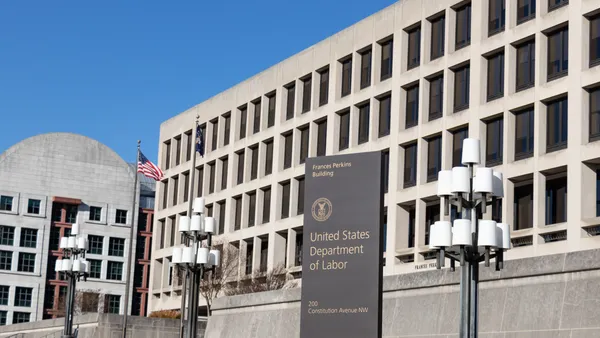Dive Brief:
- Jim Pons, a former film and video director for the New York Jets, is asking a federal court to grant him the copyright to the sports franchise’s logo and also find the team, along with the National Football League, in violation of that copyright, according to a lawsuit filed November 21 in U.S. District Court for the Southern District of New York.
- The lawsuit incorporates claims from an earlier complaint, filed in July but since dropped, that accuses the team and the league of misappropriating the logo Pons designed, using fraud to trademark the design and engaging in unfair competition and unjust enrichment for their use of the logo. The team and league also violated his publicity rights when they included Pons in a promotional video without his consent.
- “Defendants … have never paid anything to Mr. Pons for his Design,” the complaint says. “They have never paid him to assign the Design to them, have never licensed the Design from him, and have never paid any other compensation to him for the Design.”
Dive Insight:
The Jets hired Pons in 1973 as an office worker and two years later he launched the team’s in-house operations for producing video for coaching staff to use in practice, according to the complaint.
On the side, after the team said it was opening a competition for a new logo, Pons competed against, and beat out, professional graphics designers to create the new logo, his complaint said. Pons’ design was used from 1978 to 1997 and has been in use for a second time since last year.
After it adopted Pons’ work in 1978, the team amended its trademark registration to incorporate the new design. Pons was never compensated for the work.
Earlier this year, with the team once again using the logo, Pons sought to obtain the copyright for it but his application to the U.S. Patent and Trademark Office was rejected on the grounds it didn’t meet the threshold for originality.
Pons’ innovation for the design, which uses the font from the team’s original logo, was to incorporate as a part of the letter “J” a jet-like graphic that flies above the word “Jets.”
In his complaint, Pons is asking the court to grant him the copyright to the work, despite USPTO’s rejection.
“Mr. Pons’ design well exceeds the ‘extremely low’ requisite level of creativity required by law,” Pons’ attorneys say in the lawsuit on his behalf, referencing standards in copyright law, “and since it possesses at least ‘some creative spark,’ his design is entitled to copyright protection.”
What’s more, since the U.S. Supreme Court’s decision earlier this year in Loper Bright, the court owes no deference to USPTO’s decision, the lawsuit says.
Pons, 81, is seeking a share in the revenue that the team and the league generate through the sale of merchandise that includes the logo.
In a statement emailed to Legal Dive, Pons’ attorney, Lee Goldberg of Goldberg Cohen, said the Jets should fairly compensate his client. The team and the league, Goldberg said, “continue to misappropriate for enormous profit” Pons’ work, Goldberg said. “The Jets simply continue to take advantage of an unsuspecting elderly layperson. He deserves to be treated with fairness and respect.”
The lawsuit alleges the Jets acted fraudulently when it amended its trademark registration in 1978 to replace its earlier logo with the new one. In the application for the amendment, the team said the logo was first used in 1970, but the new design wasn’t created until 1978.
“The Application claimed that the Pons’ Design was first used in connection with the clothing items listed as early as January 15, 1970, and in interstate commerce with the clothing items listed as early as December 31, 1979,” the complaint says. “This statement was false – and impossible. The Design was not, and could not, have been used in 1970, since it was not created until 1978.”
Attorneys say Pons faces a tough road to prevail.
Among the arguments the team can make is that, since Pons was an employee at the time, the design is a work for hire and is owned by the team. For Pons to prevail on this basis, he would have to show that he did the work separate from his job, Eleanor Lackman, a partner at Mitchell Silberberg & Knupp, said in a Bloomberg Law report.
The team could also double down on USPTO’s rejection of Pons’ copyright application and say the design isn’t original enough for Pons to have any rights in it. But that defense comes with its own problems, because it could make it hard for the team to obtain the copyright itself, which would limit its protections, IP attorney Evan Everist of Dorsey & Whitney told Bloomberg.
Also working against Pons is the length of time that elapsed before he applied for the copyright. Pons had allowed the company to use the design for almost 20 years, between 1978 and 1997, without taking any steps to claim rights to it.
“The Jets could argue the logo’s use was clearly authorized given Pons’ longstanding acquiescence,” Bloomberg reported Everist saying.
The Jets didn’t immediately respond to a request from Legal Dive for comment but in a statement to the New York Post after Pons filed his original complaint, in July, the team said the lawsuit was without merit.
“The mark in question has been registered with the United States Patent and Trademark Office for nearly 50 years,” the team said. “The mark has been used continuously in numerous iterations since that time. We find this claim baseless and without merit.”











